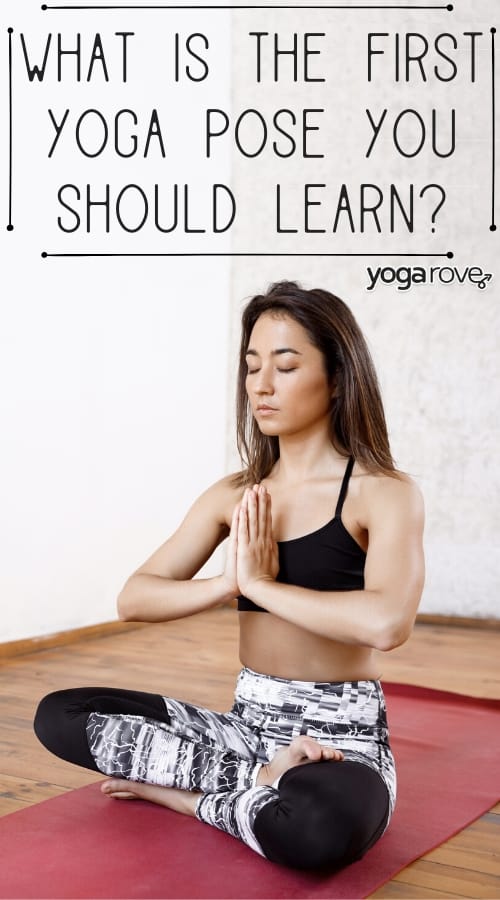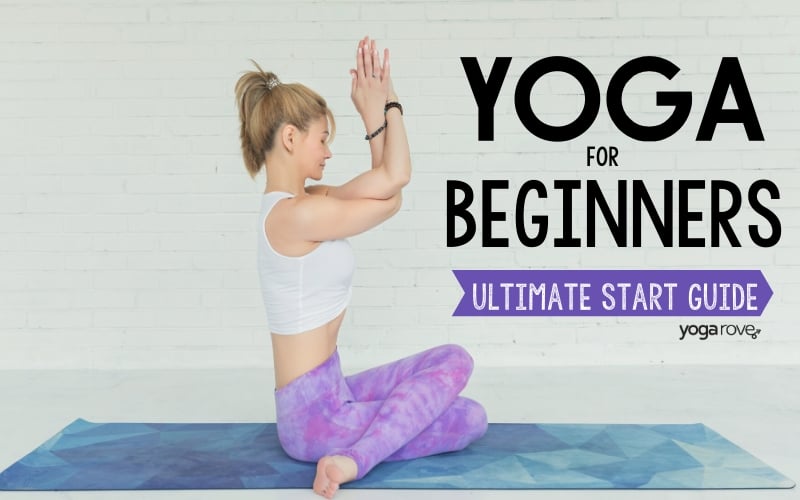This post may contain affiliate links. Please read our disclosure for more info.
Practicing yoga for over 10 years has been a joy because the process of yoga has taught me so much about myself and about my body. When thinking back at the beginning stages of yoga I was trying to figure out what the first yoga pose a beginner student should learn.

The first yoga pose to learn should be Easy Pose (Sukhasana). Easy Pose is important to learn because it provides a solid foundation of where a beginner should start their practice every session. Maintaining this pose may seem easy at first but when done correctly it will pose much strain for any beginner.
When I first started doing Easy Pose I thought I was doing it properly. It wasn’t until a couple years in that I came across a yoga teacher that helped me correct my form and taught me an easy method to maintain the position for long periods of time.
Easy Pose: Step By Step Instruction
Step 01
Make sure to place a folded blanket or pillow next to you ( this is going to provide so much support for any beginner). Sit down and bring your feet out in front of you to get into Staff Pose.
Step 02
Next, cross your shins and flex your feet. Make sure you knees are not higher than the level of your hips. This is what I always messed up on and doing the pose incorrectly caused strain on my back. To help your body with this part, sit on the folded blankets or a pillow. Adjust the amount of folded blankets or pillow size based on what is comfortable to you.
Step 03
Relax your your feet. Both shins should rest between the inner arches of your feet. Allow gravity to pull your knees to the ground.
Step 04
Lengthen your torso and imagine a string holding up the top of your head. The goal is to not slouch or let your chest cave in. Bring your hands to your heart’s center.
Check out this video from Yoga Journal to gain a deeper understanding of Easy Pose.
Things to Remember When Doing Easy Pose:
- Alternate bringing your legs in front of one another. You never want to do the same pose over and over again to cause your body to get off balance.
- Sometimes it may take you 2 blankets in order to find that comfortable position.
- Attempt to meditate in this pose. Build up to 10 minutes or more.
- Always stay engaged with the pose even if you think that it is easy. You want to form a deep connection and understanding with your body, and you can’t do that if you aren’t giving it your all in every pose you get into.
What Are the Best Yoga Positions For Beginners?
After learning about Easy Pose I want to teach you a few other yoga poses that are staples in the beginner yoga community. Practicing these poses at home individually will strengthen your yoga practice. Take the time to learn each pose individually instead of getting into a flow that doesn’t allow you to really feel out the pose to get a better feel for it.
Yoga positions for beginners:
- Table Top
- Cat and Cow
- Downward Dog
- Standing Forward Fold
- Warrior I
1. Table Top
This is a foundational pose that will be the start of many yoga flows. Getting your alignment correct in this pose is going to be beneficial in all the other poses you attempt. Remember that every pose you get into you should be actively engaging your entire body. Just because it may seem easy doesn’t mean you shouldn’t focus on having good alignment and posture.
To get into this pose come to the floor on your hands and knees. Align your hands under your shoulders with your fingers facing forward. Make sure your knees are hip distance apart.
Your gaze should be focused downward in between your hands. Press the crown of your head toward the front wall and your tailbone to the back wall to help lengthen the spine. Make sure your back is flat. Press into the palms to allow your shoulders to slightly away from your ears.
2. Cat and Cow
These are two common poses that you will practice throughout your yoga journey. I fell in love with these poses when I first started yoga because I truly believe it helped me get rid of my lower back pain. Whenever your back is feeling stiff this is a great combination of poses to practice to open up your spine.
Start off on your hands and knees in tabletop position. Have your hands placed directly below your shoulders, and your knees hip distance apart.
On your next inhale, arch your back, drop the belly, keep your shoulders back, and open up your chest. Make sure your gaze is upward toward the sky. This is Cow Pose.
On the exhale, reverse the pose by rounding out your back and bringing your head down keeping your gaze at your naval. This is Cat Pose.
After flowing in and out of each pose I like to hold each pose for at least 3 breaths, especially in cat pose. Expanding the rib cage by breathing in cat pose really opens up my back.
3. Downward Dog
When I first started learning downward dog it took me around 3 months in order for this pose to be considered a resting pose. If you are just starting out and it feels like your shoulders are on fire you are not alone! Your body will strengthen the more you practice and eventually this pose will be considered a resting pose.
Start off in table top pose, tuck your toes and push your hips up to straighten your legs.
It’s okay if your heels aren’t touching the ground. To loosen up your calves and hamstrings, pedal your feet back and forth.
Keep the palms of your hands grounded on the floor and fingers spread wide.
Here is a video tutorial yoga journal created to understand the basics of downward dog.
4. Standing Forward Fold
This is a very relaxing pose that can be used to relieve stress and anxiety, as well as loosen up your neck and shoulders.
Start off standing upright with your weight centered on the balls of your feet. Inhale both arms to the sky with the palms facing each other.
Exhale as you bend forward very slowly while keeping your legs straight. Bring your arms behind your legs for a deeper stretch.
Breath and relax in this pose to loosen up your neck and spine.
5. Warrior I
This next pose is a lot of fun because it feels very empowering once you get all the alignments correct. Remember to always stay engaged with the pose even if you think it is easy.
To begin, start off standing tall with a neutral spine. Bring your right leg back 3-4 feet behind you. Turn your back foot on an angle facing away from your body while both heels are in alignment with each other.
While bending your front knee keep your arms raised above your head with the palms facing each other. Remember to stay grounded with your feet and lift through your chest.
For a complete routine that uses most of these poses check out our 20 Minute Yoga Routine Every Beginner Needs.
Related Questions:
How Long Do You Hold A Yoga Pose?
Depending on the difficulty of the pose this answer is going to vary. If you are attempting a harder pose that you cannot quite hold just yet, attempting to hold this pose for 1 second is good enough. For beginner yoga poses you are going to want to start off with holding a pose for 10 seconds. Gradually increasing the duration of the pose you are holding will help you develop the muscle necessary to get into harder poses.
How Often Should You Do Yoga?
Yoga should be done 7 days a week. This does not mean that we want you to focus on an intense yoga session for 7 days straight. Learn to incorporate different variations of difficulty multiple times a week.
The reason you can do yoga 7 days a week is because each pose and routine has a different difficulty level. We have a yoga routine that helps you fall asleep that would be perfect for anyone to attempt every night. A routine that should only be attempted 2 to 3 times a week based on your skill level is our weight loss yoga flow.
Start off with practicing at least 5 minutes a day and a couple times out of the week increase your sessions to 15 minutes.
Continuous practice will allow you to form the habit of moving your body everyday. Creating this habit will make it a lot easier for you to sustain long lasting healthy results.
For more ideas on practicing different yoga routines check out our Yoga Resource Library.






